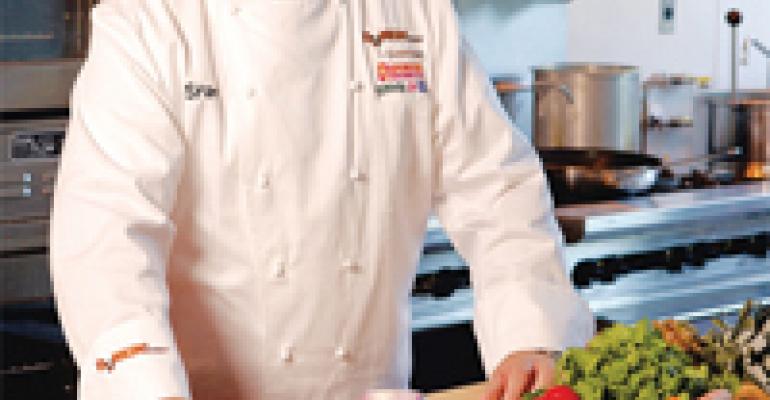Eating on the road before automobile cup holders became ubiquitous could be a messy proposition, with drinks spilling from the dashboard and sandwich contents squishing out from the sides of the bread. Now it’s not only beverages that are populating the holders: Dunkin’ Donuts, for one, is capitalizing on a trend of increased demand for on-the-go meals by designing food, and even containers, that have the multitasking driver in mind.
“Our customer is looking for good-tasting, good-quality, affordable food and drink but on the go, as fast as they can get it and get back in the car and get back in their day, so portability becomes key,” says executive chef Stan Frankenthaler.
Recent rollouts filling the need for what he calls “cup holder cuisine” include hash browns, sold in portions of nine “two-bite” pieces in a “cup holder-friendly” package, and the French Toast Twist, a stick-shaped pastry, “loaded with maple” and a custard filling and easily consumed on the go without benefit of utensils.
Frankenthaler leads the culinary team responsible for developing all new products for the company’s three brands—Dunkin’ Donuts, Baskin-Robbins, Togo’s—including beverages, savory goods, sweet goods and ice cream, to create the “gold standard” product that will meet the company’s benchmarks for quality, operations and speed of service. According to company statistics, Dunkin’ Donuts is the world’s largest coffee and baked goods chain, serving more than 3 million customers a day. The company also reports that it is the No. 1 U.S. retailer of hot, regular coffee by the cup, and it had systemwide sales of $4.7 billion in fiscal year 2006.
At Dunkin’ Donuts, an in-house Consumer Brand Insight Group, or CBIG, works with the culinary team on sensory and positioning research. Besides looking at Dunkin’ Donuts’ own consumer data, CBIG also analyzes data from outside services.
“Typically what our research group does,” he says, “is instead of relying on any one single source, they’ll look at all of those folks and they’ll put the information back together for us in a way that’s really pertinent to our market segment.”
Decisions about following trends involve considering the company’s roots and core business.
“We first and foremost really want to stay true to our brand,” Frankenthaler says, “so we’re probably not going to follow some trends that are going to take the brand in a direction that doesn’t really seem to be part of our heritage. We’re very natural in our growth and the way that we develop our menus.
“We started as great coffee, great donuts, great bakery, fresh bakery, so I think our growth naturally stems from there, whether it’s been the supreme omelet as an addition to our line, or whether it’s been some really almost decadent cookies, really loaded with great chocolate.”
Two-thirds of the company’s business is beverages, he says. In fact, hot brewed coffee, a cornerstone of the business since its founding as a single shop in 1950, is the chain’s single biggest seller.
Several recent noncoffee beverages follow trends indicating that soda consumption has declined slightly among American consumers, while frozen fruit drinks and energy drinks are growing in popularity. Last year saw the introduction of a line of smoothies made with fruit and low-fat yogurt. A tropical smoothie blend of coconut, banana and pineapple joined the roster this year, as did the new citrus-flavored energy drink developed in partnership with SoBe and a line of plain and flavored brewed iced tea.
He predicts wider use of tropical fruits and increasing familiarity with some that are now lesser known, such as mangosteen or açaí.
“Today mango seems like a safe place, right?” he says. “But I think we’ll see more of those new fruits. The pomegranate kind of created acceptance for what super fruits can do.”
8trends for ’08 “CUP HOLDER CUISINE” BROADER CONSUMER CHOICES LIGHTER FOOD ALTERNATIVES AUTHENTICALLY INTERPRETED CLASSICS WITH “GENUINENESS OF FLAVOR” RISING DEMAND FOR NONSODA BEVERAGES, SUCH AS ENERGY DRINKS MENU ITEMS DESIGNED FOR COLLEGE-AGE CUSTOMERS INCREASINGLY SAVVY CONSUMERS INCREASED USE AND ACCEPTANCE OF EXOTIC FRUITS FAD ABOUT TO FLOP? DIETARY EXTREMISM. “We are definitely moving away from that ‘single enemy’ kind of low-carb diet thing, like, ‘Oh, I’m going to eat everything I want to, except carbs,’ or ‘I’m going to eat everything I want to, except red meat,’ or ‘I’m going to eat everything I want to, except fat.’”
Frankenthaler also notes increasing consumer demand for lighter alternatives to regular menu items, such as the company’s newest rollout, the Iced Caramel Latte Lite.
When it comes to addressing dietary concerns, he says, “I think it’s about real choice within all the menu categories, and really making people feel that as their decisions may be changing a little bit, that Dunkin’ is in step with the changes they’re choosing to make as well.”
DUNKIN’ DONUTS HEADQUARTERS: Canton, Mass. UNITS: 7,293 in 31 countries PRICES: suggested retail prices vary depending on location; beverages, $1.33 for small regular coffee to $3.49 for the 32-oz SoBe Energy Coolatta; sandwiches, $2.03-$3.03; bakery goods, 86 cents for a doughnut to $7.30 for a dozen bagels BEST SELLER: brewed coffee, $1.33–$1.90, depending on size LATEST MENU ROLLOUT: Iced Caramel Latte Lite, an iced beverage made with caramel syrup, espresso, skim milk and sweetener, introduced July 2007, suggested retail price $1.99–$2.89 SLOWEST SELLER: undisclosed
Frankenthaler also notes that diners are increasingly sophisticated and thinks this will result in more authentic interpretations of classics. “Regardless of whatever level you’re serving in,” he says, “customers today are fairly savvy.”




